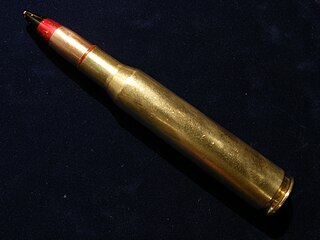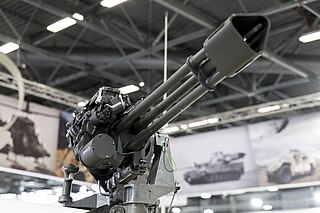
A machine gun (MG) is a fully automatic, rifled auto-loading firearm designed for sustained direct fire with rifle cartridges. Other automatic firearms such as automatic shotguns and automatic rifles (including assault rifles and battle rifles) are typically designed more for firing short bursts rather than continuous firepower and are not considered true machine guns. Submachine guns fire handgun cartridges rather than rifle cartridges, therefore they are not considered machine guns, while automatic firearms of 20 mm (0.79 in) caliber or more are classified as autocannons rather than machine guns.

In firearms terminology, an action is the functional mechanism of a breech-loading firearm that handles the ammunition cartridges, or the method by which that mechanism works. Actions are technically not present on muzzleloaders, as all those are single-shot firearms with a closed off breech with the powder and projectile manually loaded from the muzzle. Instead, the muzzleloader ignition mechanism is referred to as the lock.

A chain gun is a type of autocannon or machine gun that uses an external source of power to cycle the weapon's action via a continuous loop of chain similar to that used on a motorcycle or bicycle, instead of diverting excess energy from the cartridges' propellant as in a typical automatic firearm.
Pump action is a type of manual firearm action that is operated by moving a sliding handguard on the gun's forestock. When shooting, the sliding forend is pulled rearward to eject any expended cartridge and typically to cock the hammer or striker, and then pushed forward to load a new cartridge into the chamber. Most pump-action firearms use an integral tubular magazine, although some do use detachable box magazines. Pump-action firearms are typically associated with shotguns, although it has been used in rifles, grenade launchers, as well as other types of firearms. A firearm using this operating mechanism is colloquially referred to as a pumpgun.
The Gryazev-Shipunov GSh-23 is a twin-barreled 23 mm autocannon developed in the Soviet Union, primarily for military aircraft use. It entered service in 1965, replacing the earlier Nudelman-Rikhter NR-23 and Rikhter R-23.

The 12.7×108mm cartridge is a 12.7 mm heavy machine gun and anti-materiel rifle cartridge used by the former Soviet Union and Warsaw Pact countries, including Russia, China, Iran, North Korea, and many others. It was invented in 1934 to create a cartridge like the German 13.2mm TuF anti-tank rifle round and the American .50 Browning Machine Gun round.
Blowback is a system of operation for self-loading firearms that obtains energy from the motion of the cartridge case as it is pushed to the rear by expanding gas created by the ignition of the propellant charge.

A rotary cannon, rotary autocannon, rotary gun or Gatling cannon, is any large-caliber multiple-barreled automatic firearm that uses a Gatling-type rotating barrel assembly to deliver a sustained saturational direct fire at much greater rates of fire than single-barreled autocannons of the same caliber. The loading, firing and ejection functions are performed simultaneously in different barrels as the whole assembly rotates, and the rotation also permits the barrels some time to cool. The rotating barrels on nearly all modern Gatling-type guns are powered by an external force such as an electric motor, although internally powered gas-operated versions have also been developed.

The Heckler & KochP7 is a German 9×19mm semi-automatic pistol designed by Helmut Weldle and produced from 1979 to 2008 by Heckler & Koch GmbH (H&K). The P7M13, a variant of the P7 with a double-stack magazine, was produced until 2000.
The ShVAK was a 20 mm autocannon used by the Soviet Union during World War II. It was designed by Boris Shpitalniy and Semyon Vladimirov and entered production in 1936. ShVAK were installed in many models of Soviet aircraft. The TNSh was a version of the gun produced for light tanks. ShVAK shares the name with its 12.7 mm heavy machine gun predecessor.
The Berezin UB was a 12.7 mm caliber Soviet aircraft machine gun widely used during World War II.

The Berezin B-20 was a 20 mm caliber autocannon used by Soviet aircraft in World War II.
The Volkov-Yartsev VYa-23 is a 23 mm (0.91 in) autocannon, used on Soviet aircraft during World War II.

The Colt–Browning M1895, nicknamed "potato digger" because of its unusual operating mechanism, is an air-cooled, belt-fed, gas-operated machine gun that fires from a closed bolt with a cyclic rate of 450 rounds per minute. Based on an 1889 design by John Browning and his brother Matthew S. Browning, it was the first successful gas-operated machine gun to enter service.

The GAU-19/A is an electrically driven, three-barrel rotary heavy machine gun that fires the .50 BMG (12.7×99mm) cartridge.

The 23×115mm round is used in Soviet (USSR)/Russian/CIS aircraft autocannon. Although superseded by the 30×165mm round the Russian Air Force still uses it in the GSh-23L and the GSh-6-23. This round still serves in many countries and is widely available. The projectile weight is 175 grams.

The Afanasev Makarov AM-23 is a Soviet designed aircraft autocannon that has been used in a number of aircraft in the Soviet Air Force. Its GRAU index was 9-A-036. It was often used in place of the earlier and slower-firing Nudelman-Rikhter NR-23.
The Rikhter R-23 is an aircraft autocannon developed for the Soviet Air Force starting in the late 1950s. It was designed to be as short as possible to avoid problems found on high-speed aircraft when the guns were pointed into the airstream. The R-23 was a gas operated revolver cannon that used gas bled from holes in the barrel to provide the motive force. Firing up to 2,600 rpm, the R-23 was the fastest firing single-barrel cannon ever introduced into service.

The Gryazev-Shipunov GSh-30-1 is a 30 mm autocannon designed for use on Soviet and later Russian military aircraft, entering service in the early 1980s. Its current manufacturer is the Russian company JSC Izhmash. The name GSH-30-1 is formed from the surnames of the designers Gryazev (Грязев) and Shipunov (Шипунов), the caliber of 30 mm and the single-barrel design of the gun itself.

A repeating firearm or repeater is any firearm that is capable of being fired repeatedly before having to be manually reloaded with new ammunition into the firearm.














